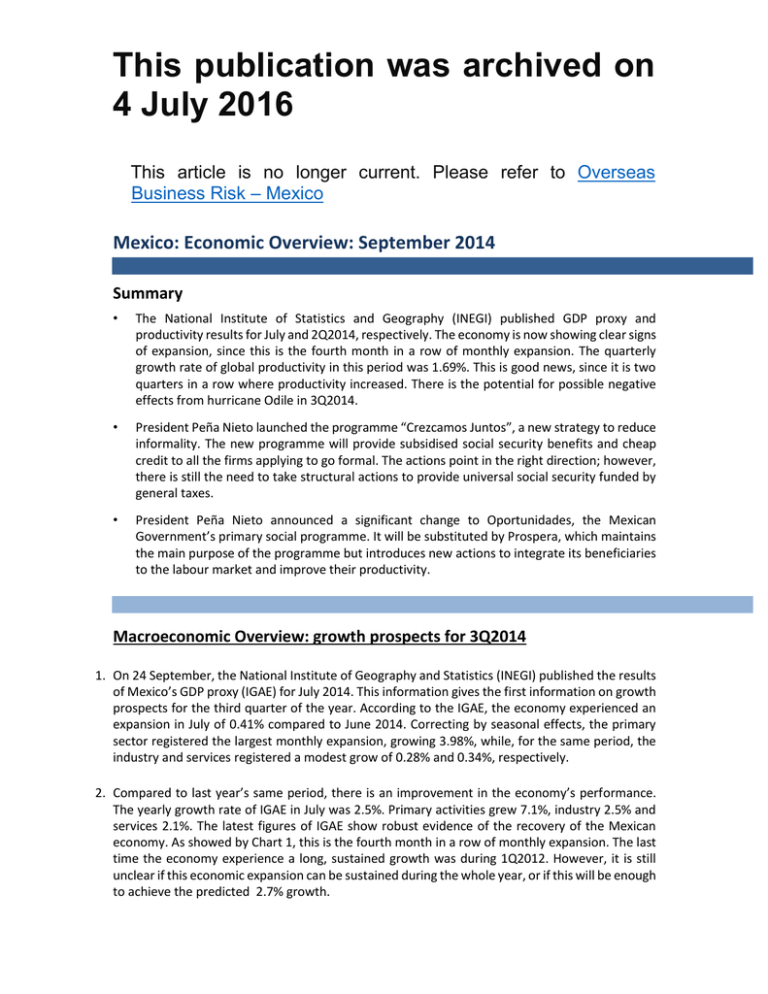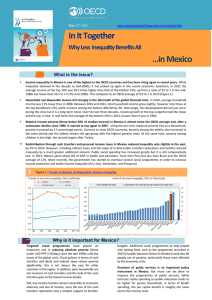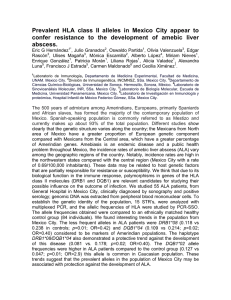Mexico: monthly economic report - September
Anuncio

This publication was archived on 4 July 2016 This article is no longer current. Please refer to Overseas Business Risk – Mexico Mexico: Economic Overview: September 2014 Summary • The National Institute of Statistics and Geography (INEGI) published GDP proxy and productivity results for July and 2Q2014, respectively. The economy is now showing clear signs of expansion, since this is the fourth month in a row of monthly expansion. The quarterly growth rate of global productivity in this period was 1.69%. This is good news, since it is two quarters in a row where productivity increased. There is the potential for possible negative effects from hurricane Odile in 3Q2014. • President Peña Nieto launched the programme “Crezcamos Juntos”, a new strategy to reduce informality. The new programme will provide subsidised social security benefits and cheap credit to all the firms applying to go formal. The actions point in the right direction; however, there is still the need to take structural actions to provide universal social security funded by general taxes. • President Peña Nieto announced a significant change to Oportunidades, the Mexican Government’s primary social programme. It will be substituted by Prospera, which maintains the main purpose of the programme but introduces new actions to integrate its beneficiaries to the labour market and improve their productivity. Macroeconomic Overview: growth prospects for 3Q2014 1. On 24 September, the National Institute of Geography and Statistics (INEGI) published the results of Mexico’s GDP proxy (IGAE) for July 2014. This information gives the first information on growth prospects for the third quarter of the year. According to the IGAE, the economy experienced an expansion in July of 0.41% compared to June 2014. Correcting by seasonal effects, the primary sector registered the largest monthly expansion, growing 3.98%, while, for the same period, the industry and services registered a modest grow of 0.28% and 0.34%, respectively. 2. Compared to last year’s same period, there is an improvement in the economy’s performance. The yearly growth rate of IGAE in July was 2.5%. Primary activities grew 7.1%, industry 2.5% and services 2.1%. The latest figures of IGAE show robust evidence of the recovery of the Mexican economy. As showed by Chart 1, this is the fourth month in a row of monthly expansion. The last time the economy experience a long, sustained growth was during 1Q2012. However, it is still unclear if this economic expansion can be sustained during the whole year, or if this will be enough to achieve the predicted 2.7% growth. This publication was archived on 4 July 2016 This article is no longer current. Please refer to Overseas Business Risk – Mexico 3. Overall productivity also shows signs of recovery. On 29 September INEGI published Mexico’s productivity indicators for 2Q2014. The quarterly growth rate of global productivity in this period was 1.69%. Compared to last year’s same quarter, productivity grew 2.2%. This is good news, since it is two quarters in a row where productivity increased. Correcting by seasonal effects, the sector that has performed better during the last two years has been services, followed by the primary sector, which has showed a strong recovery since the beginning of this year. In contrast, the labour productivity of the industry still continues to underperform since the end of 2012, which marks the beginning of Mexico’s slowdown. 4. An external element to consider in the near future is a possible negative effect of hurricane Odile on economic performance in 3Q2014. Odile, which hit the coasts of Baja California in the middle of September, caused heavy damage to hotels and public infrastructure in the zone, especially in Los Cabos. According to the National Association of Insurance Institutions, the estimated economic loss caused by Odile is approximately GBP£545m. This amount could potentially surpass the costs of last year’s hurricanes Ingrid and Manuel, which devastated the coast of Guerrero. As a response, the Mexican Government has announced they will use a special fund to address natural disasters. In addition the This publication was archived on 4 July 2016 This article is no longer current. Please refer to Overseas Business Risk – Mexico Chart 1: Monthly growth rates of GDP proxy, 2012-2014 Source: National Institute of Statistics and Geography. Time series corrected by seasonal effects 2.5 2 1.5 1 0.5 0 -0.5 -1 -1.5 Ministry of Finance will condone the payment of the income tax to firms established in the region, and will give more than five thousand credits funded by development banks. However, despite all the Government efforts to tackle this crisis, tourism could be affected during 3Q2014, with a full recovery only in 1Q2015. Policy in Focus 1: Peña Nieto launches new programme to tackle informality 5. On 8 September 2014, President Peña Nieto and Finance Minister Luis Videgaray launched the programme “Crezcamos Juntos”, a new strategy to reduce informality. As mentioned in July’s monthly economic report, informality is one of the main causes behind the sluggish growth of labour productivity over the years. The causes that the Economics Unit in Mexico identified as the This publication was archived on 4 July 2016 This article is no longer current. Please refer to Overseas Business Risk – Mexico sources of informality are the lack of access to formal and cheap credit, perverse incentives in social security (especially in health), excessive red tape, and low human capital. The programme addresses all these issues. 6. The programme will implement seven different actions. The Government will subsidise health services for the owner of the business and its employees; social security quotes will be subsidised for ten years, and the first two years workers will pay only 50% of the quota. The informal workers who decide to go formal will be immediately be added to the public pension scheme. Beneficiaries of the programme will receive a Government credit to buy a house only eight months after they start to pay housing quotas. The Government will provide lower income tax rates during ten years for firms and employer who decide to go formal; the first year it will condone 100% the first year, 90% the second year, and so on. The National Entrepreneurship Institute will provide more than 120 thousand credit to small business to acquire capital goods and tools. The development banks will provide securities to new formal small businesses, so they can acquire commercial loans with lower interest rates. Finally, all the informal workers who decide to apply to the programme will receive training from the Ministry of Labour to increase their productivity. 7. Compared to the previous Government’s approach towards informality, President Peña Nieto proposes a shift in public policy. Rather than criminalising informality, “Crezcamos Juntos” provides positive incentives to attract new business into formality. However, the need to promote structural changes in social security and in the financial system is still there. The fiscal burden of all these actions will take its toll on Government revenues, since Minister Videgaray promised there will be no further tax increases. It is more desirable to have a universal social security system funded by general taxes to provide equal grounds to all the firms rather than targeted actions that in reality punish the firms already formal and established. Policy in Focus 2: Social policy reform: from “Oportunidades” to children in order to break the poverty cycle. In the “Prospera” 8. On 2 September, during his second State of the Union, President Peña Nieto announced a significant change to Oportunidades, the main social programme of the Mexican Government. The programme consists in a conditional cash transfer (CCT) to households living in extreme poverty, on the condition of school attendance and monthly health checks. The logic behind the programme is to increase the human capital of the past, Oportunidades was praised by UNDP and the World Bank, since it increases the school enrollment and nourishment of poor children. Shortly after its creation, the Brazilian Government launched a similar initiative called Bolsa Familia. 9. However, the short and medium term results of the programme in reducing poverty rates are not encouraging. As showed by Chart 2, after a period This publication was archived on 4 July 2016 This article is no longer current. Please refer to Overseas Business Risk – Mexico of sustained reduction of poverty rates during the first decade of this century, the 2009 financial crisis increased again the number of people living in poverty in the country, returning to a level similar to 1992. There are three main criticisms to Oportunidades. First, the programme did not have a clear link between social and economic policy. Second, the CCT only covered primary Chart 2: Poverty head count ratio, 1992-2014 80 70 69 63.7 60 52.4 53.6 53.1 50 50 47.8 47.2 46.9 52.3 51.1 47 42.9 41.7 40 30 30 37.4 31.8 29.7 33.3 26.9 25.5 24.7 24.7 26 28 20.9 20 21.4 21.2 24.1 20 17.4 18.6 18.2 18.8 19.7 14 10 0 1992 1994 1996 1998 2000 2002 2004 2005 2006 2008 2010 2012 Alimentary poverty Capabilities poverty Patrimonial poverty Source: National Council for the Evaluation of Social Policy. The headcount ratio is defined as the percentage of people with a current income under the poverty line. The Mexican methodology calculates the poverty lines as the monetary value of a basket of different basic goods and services. and secondary education, with little to no attention to tertiary and college, which have the highest returns on future income. Finally, the programme overlooks the fact that many of the schools in poor zones do not have the minimum quality to provide the capabilities needed to compete in the labour market. As a result, the programme increases the schooling of the poor children but does not secure the proper set of tools to increase social mobility. 10. Prospera will substitute Oportunidades in order to tackle some of these problems. The beneficiaries of Oportunidades will remain under Prospera. The programme will now give scholarships for high school and technical education, and cash transfers for students who want to go to college. In addition, more than 6 million women will have access to subsidised credits from development banks, saving accounts and life insurances. To link social and economic policy, the students of Prospera will receive labour training as well as credits to start their own business. This publication was archived on 4 July 2016 This article is no longer current. Please refer to Overseas Business Risk – Mexico Finally, the health coverage will increase, almost doubling the number of services included in the basic package of the programme. 11. Whilst these changes are very positive,empirical evidence shows that macroeconomic shocks could severely affect poverty rates. High levels of inflation and vulnerability to spikes in commodity prices could severely affect consumption of basic goods. . Monthly Economic Monitor 12. Banxico’s September survey maintains its 2014 GDP growth expectations in 2.47%. The outlook of the Mexican economy for 2H2014 is improving, since new data published on September shows more signs of recovery. If the growth rates for 3Q2014 and 4Q2014 improves, the Government may achieve an annual growth rate around 2.4%. Whilst the August survey had a 3.85% forecast for 2015, in September this forecast slightly decreased to 3.83%. In this context and with this new and updated information, the 2.4% forecast of the IMF seems achievable. 13. The end year general inflation forecast for 2014 and 2015 increased to 3.97% and 3.47, respectively, within Banxico’s benchmark (3%+/-1). It is worth mentioning that there are no signs of inflationary pressures caused by underlying factors, but the Central Bank need to focus its attention on commodity prices spikes. 14. Forecasts for the Mexican peso (MXN) reflect a solid and stable currency and a more optimistic environment during the year for emerging markets. The USD/MXN year-end expected exchange rate for 2014 is 13.08. Consensus Forecast (September 2014) 2014 GDP (growth) Inflation Exchange Rate (year-end) 2.47% 3.84% 12.94 Vs. August 2014 = Source: Bank of Mexico survey on private sector expectations 2015 3.85% 3.45% 12.85 Vs. August 2014 This publication was archived on 4 July 2016 This article is no longer current. Please refer to Overseas Business Risk – Mexico Disclaimer The purpose of the FCO Country Update(s) for Business (”the Report”) prepared by UK Trade & Investment (UKTI) is to provide information and related comment to help recipients form their own judgments about making business decisions as to whether to invest or operate in a particular country. The Report’s contents were believed (at the time that the Report was prepared) to be reliable, but no representations or warranties, express or implied, are made or given by UKTI or its parent Departments (the Foreign and Commonwealth Office (FCO) and the Department for Business, Innovation and Skills (BIS)) as to the accuracy of the Report, its completeness or its suitability for any purpose. In particular, none of the Report’s contents should be construed as advice or solicitation to purchase or sell securities, commodities or any other form of financial instrument. No liability is accepted by UKTI, the FCO or BIS for any loss or damage (whether consequential or otherwise) which may arise out of or in connection with the Report.



